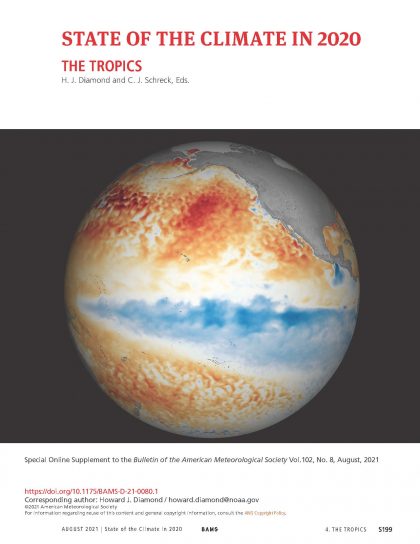ARL Weekly News – August 27, 2021
| Recent Events |
2020 State of the Climate Report Published

Tropics Chapter cover for the 2020 edition of the annual State of the Climate Report, published by NCEI and BAMS.
The 2020 edition of the annual State of the Climate Report was published and released on August 25, 2021. The report, compiled by NOAA’s National Centers for Environmental Information, is based on contributions from scientists from around the world. It provides a detailed update on global climate indicators, notable weather events, and other data collected by environmental monitoring stations and instruments located on land, water, ice, and in space. This is the 31st issuance of the annual assessment now known as State of the Climate, published in the Bulletin since 1996. This year’s report is based on contributions from more than 530 scientists from over 60 countries around the world and reflects tens of thousands of measurements from multiple independent dataset. It provides a detailed update on global climate indicators, notable weather events and other data collected by environmental monitoring stations and instruments located on land, water, ice and in space.
As a supplement to the Bulletin, its foremost function is to document the status and trajectory of many components of the climate system. However, as a series, the report also documents the status and trajectory of our capacity and commitment to observe the climate system. ARL’s Dr. Howard Diamond served as the Lead Editor for the Tropics Chapter, and this issue marked his 15th year in that role, and his plan is to do this for his 16th edition for the 2021 report. The Tropics Chapter can be found at https://ametsoc.net/sotc2020/Chapter-4-BAMS2020-FINAL.pdf, and the full report can be found at https://www.ametsoc.org/index.cfm/ams/publications/bulletin-of-the-american-meteorological-society-bams/state-of-the-climate/
Among its findings, the Tropics Chapter portion of the report documented that the number of global tropical cyclones were well above average overall. There were 102 named tropical storms during the Northern and Southern Hemisphere storm seasons, well above the 1981–2010 average of 85. Three tropical cyclones reached Saffir–Simpson scale Category 5 intensity. The North Atlantic hurricane basin recorded a record 30 named storms, surpassing the previous record of 28 in 2005. Seven of those storms became major hurricanes, matching 2005 for a record number. In the North Atlantic, a record 30 tropical cyclones formed, surpassing the previous record of 28 in 2005. Major Hurricanes Eta and Iota made landfall along the eastern coast of Nicaragua in nearly the same location within a two-week period, impacting over seven million people across Central America. In the western North Pacific, Super Typhoon Goni was the strongest tropical cyclone to make landfall in the historical record and led to the evacuation of almost 1 million people in the Philippines. Very Severe Cyclonic Storm Gati made landfall over Somalia, the first storm of such intensity to do so.
CCME Science Advisory Council Annual Meeting
LaToya Myles delivered a presentation during the annual meeting of the NOAA Center for Coastal and Marine Ecosystems (CCME). As a member of the CCME Science Advisory Council, she provided an update on the Council’s activities and future directions in support of CCME’s research to address issues confronting marine and coastal communities. CCME is led by Florida A&M University in partnership with Bethune-Cookman University; California State University Monterey Bay; Jackson State University; Texas A&M University-Corpus Christi; and University of Texas Rio Grande Valley.
NOAA Cooperative Science Center in Atmospheric Sciences and Meteorology (NCAS-M) Meeting
LaToya Myles gave a presentation at the annual meeting of the NOAA Cooperative Science Center in Atmospheric Sciences and Meteorology (NCAS-M). As a mentor for multiple NCAS-M students over the years, she spoke about internship strategies and opportunities as well as gave an brief overview of ARL.
2021 National Weather Association Conference Presentation
Travis J. Schuyler attended the 2021 National Weather Association conference and presented our work assimilating meteorological data collected via a small Uncrewed Aircraft System (sUAS) into numerical weather prediction (NWP) models to improve weather forecasts. This work also utilized the sUAS-nudged NWP models to simulate improved dispersion forecasts through advancements made to NOAA ARL’s Hybrid Single-Particle Lagrangian Integrated Trajectory (HYSPLIT) model. This work directly benefits the National Weather Service’s Weather Forecasting Offices, whom use HYSPLIT dispersion models during emergency response events (i.e. chemical spills, train derailments, wildfires, etc.) to advise Decision Support Services disseminated to the public.
Schuyler, T.J., Lee, T.R., Hotz, D., Cohen, M., Dumas, E.J., Loughner, C.P., Ngan, F., Zinn, S., Buban, M., Baker, C.B., Matthews, G. “Including sUAS-Collected Meteorological Data in Numerical Weather Prediction Models to Improve Dispersion & Weather Forecasts.” National Weather Association 46th Annual Conference, August 21-25th, 2021 Tulsa, OK, (Poster).
| Recent Publications |
Paper accepted
A manuscript entitled “When and where horizontal advection is critical to alter atmospheric boundary layer dynamics over land: The need for a conceptual framework” on which Temple Lee and Michael Buban were listed as coauthors was accepted for publication in Atmospheric Research. In the paper, the authors assert that horizontal advection is oftentimes neglected in boundary layer studies and, using examples from four advection-dominated boundary layer regimes, demonstrate that having a better understanding of horizontal advection is critical for a more thorough understanding of boundary layer thermodynamics and kinematics. Preprint available: https://doi.org/10.1016/j.atmosres.2021.105825

